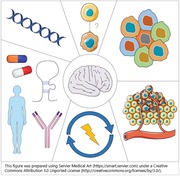Gliomas are the most typical major mind tumors in adults. They come up in the glial tissue and primarily happen in the mind. Low-grade tumors of World Health Organization (WHO) grade II are likely to progress to high-grade gliomas of WHO grade III and, ultimately, glioblastoma of WHO grade IV, which is the most typical and lethal glioma, with a median survival of 12-15 months after ultimate analysis.
Knowledge of the molecular biology and genetics of glioblastoma has elevated considerably in the previous few years, giving rise to classification strategies that may assist in administration and stratification of glioblastoma sufferers. However, glioblastoma stays an incurable illness.
Glioblastoma cells have acquired genetic and metabolic variations in order to maintain tumor progress and development, together with adjustments in energetic metabolism, invasive capability, migration, and angiogenesis, that make it very troublesome to seek out appropriate therapeutic targets and to develop efficient medicine. The present normal of look after glioblastoma sufferers is surgical procedure adopted by radiotherapy plus concomitant and adjuvant chemotherapy with temozolomide.
Although progress in glioblastoma therapies in latest years has been extra restricted than in different tumors, quite a few medicine and targets are being proposed and many medical trials are underway to develop efficient subtype-specific therapies.

The molecular biology of intracellular occasions throughout Coronavirus an infection cycle.
CoV-2 which is the causative agent of COVID-19 belongs to genus betacoronaviruses. The sequence evaluation of S protein of CoV-2 has proven that it has acquired a ‘polybasic cleavage website’ consisting of 12 aminoacids that has been predicted to allow its cleavage by different mobile proteases probably growing its transmissibility.
The aminoacids current in receptor binding area of S protein of SARS CoV that are crucial for its binding to mobile receptor are completely different in CoV-2. The presence of heptanucleotide slippery sequence in ORF1 ensuing in ribosomal frameshifting, and presence of transcription regulatory sequences between ORFs ensuing in discontinuous transcription, are peculiar options of Coronavirus an infection cycle.
The exonuclease exercise of nsp14 offers potential proofreading capacity to RNA polymerase makes coronaviruses completely different from different RNA viruses permitting coronaviruses to take care of their comparatively massive genome dimension. This mini-review summarizes the peculiar options of Coronaviruses genome and the crucial occasions throughout the an infection cycle with give attention to CoV-2.
